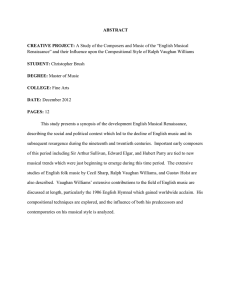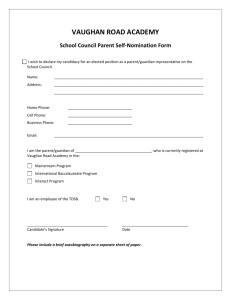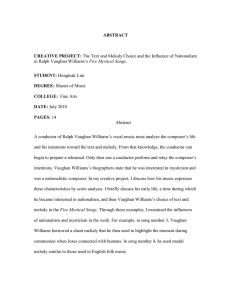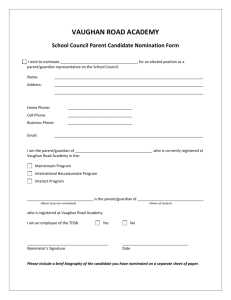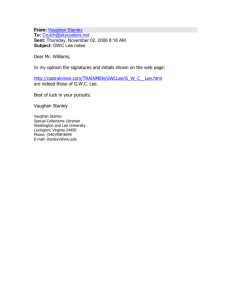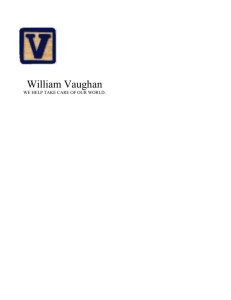A STUDY OF THE COMPOSERS AND MUSIC OF THE “ENGLISH... RENAISSANCE” AND THEIR INFLUENCE UPON THE COMPOSITIONAL STYLE
advertisement
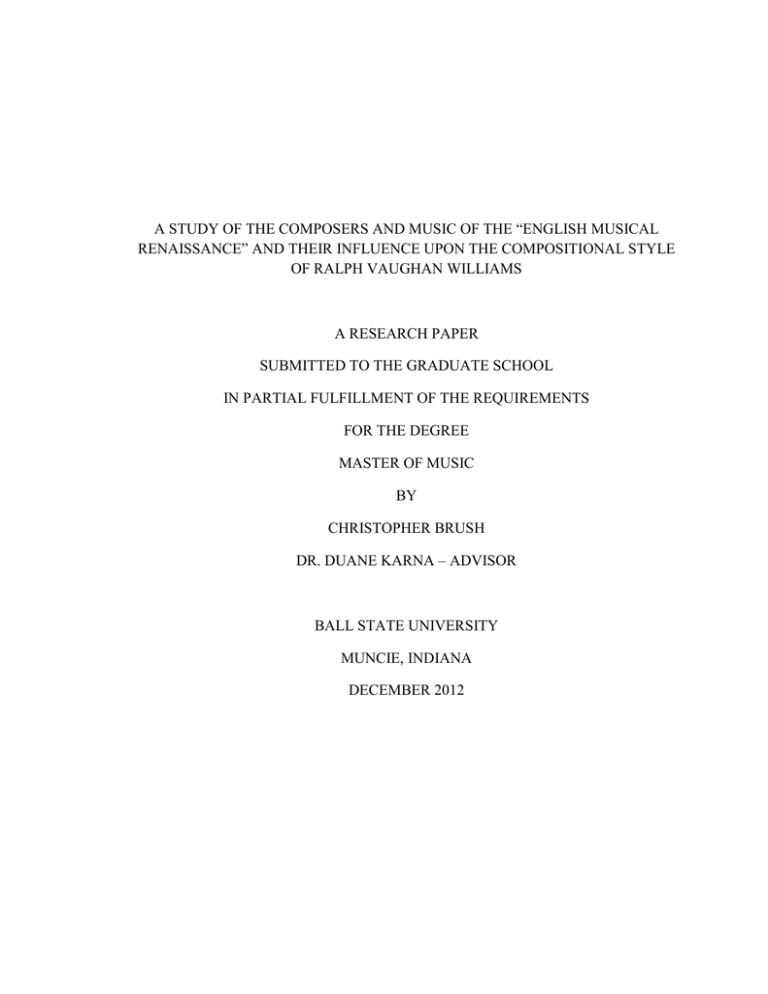
A STUDY OF THE COMPOSERS AND MUSIC OF THE “ENGLISH MUSICAL RENAISSANCE” AND THEIR INFLUENCE UPON THE COMPOSITIONAL STYLE OF RALPH VAUGHAN WILLIAMS A RESEARCH PAPER SUBMITTED TO THE GRADUATE SCHOOL IN PARTIAL FULFILLMENT OF THE REQUIREMENTS FOR THE DEGREE MASTER OF MUSIC BY CHRISTOPHER BRUSH DR. DUANE KARNA – ADVISOR BALL STATE UNIVERSITY MUNCIE, INDIANA DECEMBER 2012 1 Since the latter portion of the 1800s, the resurgence of English music has been described as a “renaissance.” The viability of this description has never been widely challenged, although some scholars have expressed questions about its appropriateness; in 1960, Arthur Jacobs noted that this characterization was “a comic overstatement without any serious attempt at computation” (Howes, 1966). We find that many musical scholars can agree about two points regarding English music of the last one-and-a-quarter centuries: first, its quality is a marked improvement over that of the period which preceded it, and second, the musical culture of England has taken on much greater significance during this same timeframe. This study will focus upon the climate of England in the time from 1840 to 1940, which is colloquially known as the English Musical Renaissance, and describe how the composers of this time period were influential upon the career of Ralph Vaughan Williams. Historically, much of the world’s greatest music has been written by composers from the British Isles. The music of Tallis, Byrd, Gibbons, and Dowland is among the finest of the Renaissance, and Purcell and Handel in succession are noted for their dominating presence in English music during the Baroque era (Routh, 1971). However, following Handel’s death in 1759, the gradual decline of British music that began during the Georgian era worsened, causing any prevailing sense of a national voice to disappear for nearly one hundred years. Under the rule of Queen Victoria, the arts were considered to be at best a “luxury,” and were often viewed as a remnant of eighteenth-century excesses, which led to an environment which was difficult at best for most artists (Hughes & Stradling, 2001). 2 While national schools of compositional thought had emerged throughout mainland Europe long before the twentieth century, nationalism in English music showed a particular resurgence at the end of the Romantic era (Schrock, 2009). Ralph Vaughan Williams, one of the leading proponents of the renewed focus on English folk music, prophetically stated that “new wine cannot be put into old bottles” as he and his contemporaries charged forward with new and exciting techniques which would continue to redefine British music in the twentieth century (Manning, 2008). The composers who worked during this period had a vast impact upon the music of all composers who have written music in the British Isles since that time. In determining the factors which were influential in the compositional method of Ralph Vaughan Williams, it is first helpful to consider the musical climate in England during his lifetime as well as the years which immediately preceded it. During the eighteenth and nineteenth centuries, there was a precipitous decline in the overall quality of music which was produced in the British Isles. The reasons for this decline are varied. First, the numerous English wars of the seventeenth century and their effect on the nation led to a breakdown in the secular traditions of the Baroque in England, both in and outside of the context of music. Next, Henry Purcell began incorporating many “continental” elements into his operatic works, followed by George Frederic Handel’s somewhat haphazard infusion of various Italianate opera techniques (Howes, 1966). In the absence of contemporaries or successors who were of a similar talent to maintain the course, and with no contemporary national voice or compositional style in evidence, the state of English music descended into a period of vapidity which would continue for 3 nearly hundred years. The exceptionally poor quality of many of the librettos which were set by composers of the generation of English composers who followed Handel was the ultimate cause of their failure in many cases, as the music simply could not overcome the weaknesses of the script. This decrease in quality led to a significant decline in the production of new operatic works in England. In addition, art music during the Victorian Period was considered to be a luxury. The cultural aesthetic of the time was one in which practical knowledge was more strongly valued than “pure” intellect. This sentiment reinforced the belief that music was not a strong feature of the arts in England (Hughes & Stradling, 2001). This is not to say that musical repertoire was not being written during this time period; on the contrary, composers including Samuel Wesley, Henry Bishop, George Alexander Macfarren, John Francis Barnett, Joseph Barnby, and many others wrote prolifically, and were frequently performed throughout the country. What is worthy of note is the relative lack of substance in the majority of this music during this period of more than a century (Strimple, 2002). As noted by the American music critic David Gregory Mason, upon hearing a piece of British music composed and first performed in 1893: How this music call up the atmosphere of the typical English choral festival; the unwieldy masses of singers, the scarcely less unwieldy orchestra or organ, the ponderous movement of the music, half majestic, half tottering, as of a drunken elephant, the well-meaning ineptitude of the expression, highly charged with good nature but innocent of nuance! There is the thin disguising of the tendency of this hymn-tune like type of harmony to sit down, so to speak, on the accent of each 4 measure, by a few conventional suspensions. There is the attempt to give the essentially stagnant melody a specious air of busyness by putting in a triplet here and a dot or a short rest there. And there is the sing-song phraseology by which a phrase of four measures follows a phrase of four measures as the night the day. In short, there is the perfectly respectable production of music by yard, on the most approved pattern, undistorted by a breath of personal feeling or imagination (Strimple, 2002). Mason’s despair notwithstanding, it was during this point in time that the emergence of four Victorian-era composers was beginning to revive and redefine English music; indeed, the works of Sir Arthur Sullivan, Hubert H. Parry, Charles Villiers Stanford and Edward Elgar would lay the groundwork of what has become known as the “English renaissance”, reestablishing a national voice for British composers and extricating British music from the formulaic and sentimental tendencies which had become predominant (Mellers, 1952). Particularly thanks to Elgar, whose oratorios gained great popularity and were performed throughout the world at the turn of the twentieth century, a new sense of unification and aesthetic was emerging in the musical community of England which had been noticeably absent for well over one hundred years (Strimple, 2002). In addition to the great musical talents which each of these men possessed, their influences, studies and experiences beyond the British Isles had a significant effect of the stylistic developments and musical aesthetic which emerged during their era of prominence. After studying at the Royal Academy of Music, a sixteen year old Arthur Sullivan enrolled and completed further studies at the Leipzig Conservatory (Strimple, 2002). Although Charles Villiers Stanford traveled less widely than many of his 5 contemporaries, he is nonetheless known to have been strongly influenced by the music of Johannes Brahms (Pirie, 1979). Early in his career, Hubert Parry deliberately sought instruction in counterpoint from Brahms, though he never ultimately studied with the great German composer. Parry was also strongly influenced by the works of Felix Mendelssohn. Upon being introduced to the works of Richard Wagner works by theorist Edward Dannreuther, Parry became so drawn to Wagner’s music and compositional method that he made numerous trips to Bayreuth; Edward Elgar also traveled frequently to Germany, experiencing numerous examples of Wagner’s music dramas at Bayreuth in 1892 and also the complete Ring cycle the following summer at Munich (Schrock, 2009). While the stage had now been set for a significant reemergence of the English compositional style by this point, England’s musical community lacked a figurehead of the scope and influence of previous English masters such as Purcell and Handel; the emergence of Ralph Vaughan Williams in the first years of the twentieth century saw this role filled, with Vaughan Williams reigning as the leading English composer for several decades. His compositional output is massive in scope, and he composed successfully in nearly every genre (although notably, he wrote few examples of opera, none of which were abundantly successful). As a student at the Royal Academy of Music, Vaughan Williams was a student of Stanford. The young Vaughan Williams would be a source of great frustration for Stanford; he would later reflect that “Stanford’s greatness as a teacher (was) his intolerance and narrow-mindedness. Stanford was known for a firm philosophical stance that ‘if a thing was right it was right; and if it was wrong it was wrong, and there was no question about it’” (Karolyi, 1994). Soon after, Vaughan 6 Williams collected his first folk tune, inciting the beginning of the English folk-song movement for which he would advocate and continue to develop throughout his long career. Scholars have surmised that Holst’s and Vaughan Williams’ fascination with, and affinity for, folk songs may have been part of their reaction to the music of composers such as Wagner and Strauss. They placed significant value on the diatonicism and modal qualities of the folk tunes which they collected (Pirie, 1979). It is interesting to note that, although Holst and Vaughan Williams both considered themselves to be rebels, they also believed they were England’s musical heirs, and felt compelled to sustain the stillemerging English compositional voice; this may suggest that Stanford’s influence upon Vaughan Williams during the early part of his career was greater than he wished to admit. Although Ralph Vaughan Williams enjoyed popularity and success early in his career, he received mostly polite reception from the musical elite of the time and was not yet recognized as either a revolutionary composer or a leader of England’s contemporary composers. In 1903, with his career at a crossroads and critics longing for “something really original” to emerge in his works, Vaughan Williams confided his concerns to Gustav Holst, who admitted to sharing them about his own works. The two composers sought an audience with Edward Elgar, each hoping to obtain the revered composer’s insight on how to develop a more unique and mature compositional voice. Both were rejected by Elgar, who had no desire to indulge the young composers who were already gaining popular favor (Routh, 1974). Soon thereafter, it was the inspiration of fellow composer and theorist Cecil Sharp which ultimately set the stage for one of Vaughan Williams’ most notable achievements: his work in collecting, preserving, and 7 disseminating vast amounts of English folk music which previously existed only through oral tradition. Vaughan Williams’ significant recognition for his collection of English folk music notwithstanding, Cecil Sharp may rightly be regarded as the father of the English folklore revival which occurred at the turn of the twentieth century. His interest in folk dances and melodies evolved from his work as a teacher; he recognized that the commonly utilized German pedagogical methods were in fact based in the folk music of Germany, which created great interest on Sharp’s part in the folk music of his native country. Sharp began to write extensively of his folk music studies while simultaneously criticizing the work of composers including Holst and Vaughan Williams. He doubted the supposed “renaissance” of which he was not a part, and questioned the significance of their contributions to English music (Hughes & Stradling, 2001). Sharp’s treatises were rebuffed by some of his contemporaries, and it was ironically Vaughan Williams who stepped to his defense, also noting the relative lack of attention on the folk music of England. Vaughan Williams became so intrigued by this virtually untapped well of musical tradition that he set out the following summer for Norfolk to study the area’s musical traditions. He stayed for a month and became enamored with the local music he discovered. This would be the first year of a decade-long stretch where Vaughan Williams traveled to Norfolk, Surrey, and Sussex during the summer months to document the native music of these regions (Hughes & Stradling, 1993). Vaughan Williams’ approach was much different than that of Sharp, who painstakingly sought to record as much English folk music as was possible; Vaughan Williams, on the other hand, was focused upon collecting “fine tunes” and disseminating them to the country as quickly as 8 possible. Sharp also tended to place emphasis on the texts of his folk song surveys, while Vaughan Williams was more interested in the melody (Pirie, 1979). It was by the recommendation of Cecil Sharp that Ralph Vaughan Williams was chosen as editor of the 1906 English Hymnal. This work marked the first connection between the Anglican Church and the influence of the English Musical Renaissance. Vaughan Williams saw the hymnal as a device to promote the national music of England via the Church, and he sought to eliminate both Victorian sentimentalism and bad taste from its pages (Hughes & Stradling, 2001). Vaughan Williams invited Gustav Holst and John Ireland to gather and arrange tunes for the 1906 English Hymnal, thereby adding the input of contemporaries who were also invested in the personal study of English folk music. In its first half century, the 1906 English Hymnal sold over five million copies, and its settings of tunes and hymns can be found in churches of numerous denominations throughout the world (Strimple, 2002). By virtue of this significant project, Vaughan Williams was able to quickly spread the aesthetic of the English Musical Renaissance beyond the shores of the British Isles. From this point forward in his career, Vaughan Williams would maintain a focus on his two primary passions. He was appointed music director of the Stratford Festival Shakespeare Company in 1913, and also continued to work on his opera Hugh the Drover. At this point, Vaughan Williams stood second only to the legendary Edward Elgar in terms of public reception; the popular opinion would soon swing in Vaughan Williams’ favor upon the relatively poor reception of Elgar’s Symphony o. 2 and his opera Falstaff (Howes, 1966). In the ensuing years, Vaughan Williams composed many 9 outstanding works with strongly nationalistic themes, elements, and musical subjects; his extensive range of compositions is among the most diverse and prolific catalogs of any of his contemporaries. In determining the maturation point of this English Musical Renaissance, we look to Gustav Holst as another composer of significant influence. Holst had a unique ability to include new elements into his works while incorporating them in a way which was still reflective of typical English conventions. It is this inner struggle between Holst’s desire to explore a wider scope of musical possibilities than his predecessors and his wishes to retain the “Britishisms” which continued to keep his music in the favor of English audiences throughout his career. In many ways, Holst’s struggle with these two conflicting desires is representative of the larger issues which had affected English music for more than a century at the beginning of his career (Mellor, 1952). We also find that Holst had a particular interest in the folk music of the English countryside, much like his friend and contemporary Ralph Vaughan Williams. Although these two composers both possessed a deep fascination with the folk tunes of rural England, and remained friends throughout their lives, this shared interest is one of a relatively few features which they share in common as composers. While Holst’s compositions are found to be quite personal and expressive, they also suggest stylizations and formal structures which would strongly influence the next generation of English composers as they sought to reestablish a national voice for British music (Strimple, 2002). Holst, who was personally aligned with Vaughan Williams throughout his life, can be considered one of his greatest contemporaries and among his greatest allies. Their innovations helped to drive 10 resurgence in the national music of England, and are a clear indication that the English Musical Renaissance had reached its heights in their mature works. In conclusion, when one examines the compositional output and timeline of the career of Ralph Vaughan Williams, it is clear that the unique environment of Great Britain at the time of the English Musical Renaissance created the perfect opportunity for the composer to leave a lasting influence upon English music in the twentieth century. The improved political and social climate of the late nineteenth century coupled with a departure from Victorian-era conventions which had constricted England’s national music over the previous hundred years led to a revitalized English musical community in the early twentieth century which was ready for a revolutionary musical leader with a highly English aesthetic. Ralph Vaughan Williams assumed that role with ease, and served as England’s musical figurehead for decades. The indelible mark of Vaughan Williams on this time period cannot be underestimated, and his influences as well as his own influence upon other composers can clearly be traced to the English Musical Renaissance of 1840 to 1940. REFERECES Howes, F. (1966). English Musical Renaissance. New York, NY: Stein and Day. Karolyi, O. (1994). Modern British Music. Cranbury, NJ: Associated University Press. Manning, D. (2008). Vaughan Williams on Music. New York, NY: Oxford University Press. Pirie, P. (1979). The English Musical Renaissance. New York, NY: St. Martin’s Press. Routh, F. (1972). Contemporary British Music. London: Macdonald and Company. Stradling, R. and Hughes, M. (1993). The English Musical Renaissance 1860-1940: Constructing a $ational Music. New York, NY: Palgrave. Stradling, R. and Hughes, M. (2001). The English Musical Renaissance 1840-1940, Second Edition. New York, NY: Routledge. Strimple, N. (2002). Choral Music in the Twentieth Century. Pompton Plains, NJ: Amadeus Press. Schrock, D. (2009). Choral Repertoire. New York, NY: Oxford University Press. Ulrich, H. (1973). A Survey of Choral Music. New York, NY: Harcourt Brace Jovanovich.
